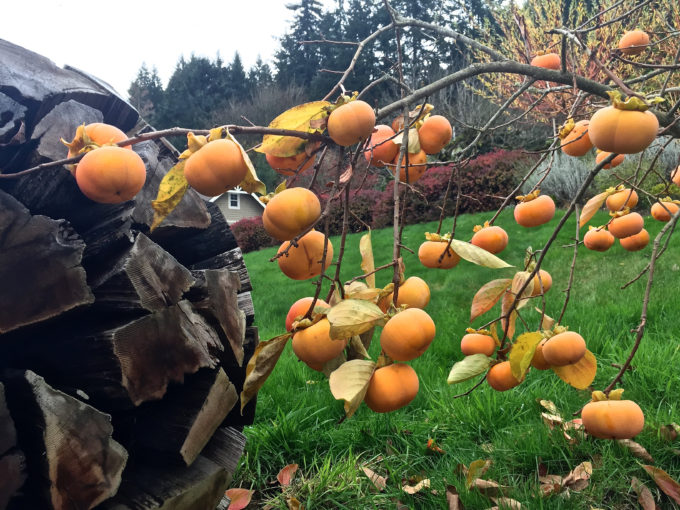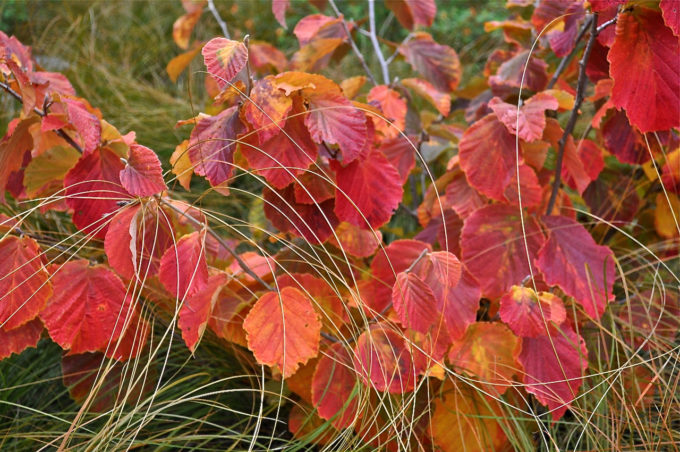ORANGE epitomizes fall. Fields of ripe pumpkins ready for harvest; Japanese persimmons turning deeper orange as the weather cools; dahlias ruling the garden, like my new orange favorite ‘Maarn’ with four-inch, pure orange pompons. ORANGE is optimistic, uplifting, and rejuvenates our spirit, particularly after a long, dry northwest summer.

From a series of articles I’ve written on COLOR IN THE GARDEN for the Hardy Plant Society of Oregon Quarterly publication.

I didn’t realize how much I favor orange flowers in our own garden until I sat down to write this article. Early in the season, it starts with Papaver atlanticum (Atlantic poppy) in single and double ‘Flore Pleno’ flower form. This delightful poppy reseeds freely on our hilliside offering wave after wave of orange. The same goes for California poppy (Eschscholzia californica). Another favorite orange-hued perennial is Alstroemeria ‘Butterscotch’ gifted to to me by Lucy Hardiman (with more plants purchased at Joy Creek Nursery). Its butterscotch and apricot tones seem to complement many companion plants on our hillside. It offers continuous mellow, pastel color points well into fall.
I am a big fan of late summer and fall-blooming Agastache (misleadingly called anise-hyssop or licorice mint) in all shades of orange. Among my favorite selections are Agastache aurantiaca ‘Shades of Orange’, ‘Mandarin Dream’ (the color of Mandarin oranges), ‘Rainbow Sorbet’ (big, flared orange flowers that shift pink over several days giving a multi-color effect), and shorter compact selections like ‘Apricot Sprite’ (peachy apricot) and ‘Xera Flame’ (orange-red).
Another orange perennial that keeps trucking in our fall borders is Kniphofia thompsonii var. snowdenii. I favor spiky perennials that punctuate border designs and this poker is a showstopper. Rather than the regular congested arrangement of flowers this Kniphofia sports widely spaced multicolored tubular flowers in candy corn orange and hints of yellow. Each flower stem rises to 4’ tall; new spikes repeat through fall and continually surprise.
Flower color is obvious, but don’t overlook orange fruit. I adore Japanese persimmon (Disopyros kaki ‘Fuju’) for the beautiful shape of its deep orange fruits that persist after leaf drop into early winter. The specimen in Portland’s Lan Su Chinese Garden is to die for!
Other favorite orange-fruited shrubs are Viburnum setigerum (tea viburnum) with heavy dangling clusters of orange-red fruits (perhaps the best fruit display of any of the viburnums) and species Rosa rugosa with cherry-tomato-sized hips in arresting orange-red. R. rugosa cultivars ‘Alba’ (single white), ‘Hansa’ and ‘Therese Bugnet’ (double pinks) and ‘Blanc Double de Coubert (double white) all produce colorful hips in gardens that I have designed.
For fall foliage with plays of orange, Hamamelis x intermedia ‘Diane’ and Parrotia persica are hard to beat. Other standouts include Japanese maples, particularly selections like Acer palmatum ‘Orange Dream’ with its stunning orange new growth and yellow-orange fall color. Forever tucked in my mind is a beautiful dissected Acer palmatum ‘Waterfall’ which reliably shifts brilliant orange-red in the Japanese Hill-and-Pond Garden at Brooklyn Botanic Garden. That maple is now easily challenged by specimens in Portland’s acclaimed Japanese Garden.
Gardeners often forget that stem and bark color extend interest in the fall and winter. Euphorbia griffithii ‘Dixter’ glows with orange-red stems in our hillside borders during September and October. Cornus sanguinea ‘Winter Flame’ (and ‘Midwinter Fire’) offer brightly colored winter stems that flicker yellow, orange and red. Acer griseum (paperbark maple) is small tree standout for its exfoliating copper orange to cinnamon reddish/brown bark and showy orange to red fall color.
Since moving back to the West Coast five years ago, I have renewed my love affair with Zauschneria (now Epilobium) species and hybrids. My favorite upright forms (at least for now!) are Zauschneria ‘Bowman’ to 2 feet tall with vermillion-orange flowers and ‘Silver Select’ to 20 inches tall with silver foliage and bright orange flowers.
Remember to knit together plantings with Carex testacea (orange sedge…and don’t forget annuals and vegetables that spread an orange glow in the autumn garden. Among my favorites are Bulbine frutescens ‘Hallmark’, Calibrachoa Superbells ‘Dreamsicle’, Oxalis ‘Copper Glow’, tomato ‘Sungold’ (yum!) and a new favorite from Xera Plants, Antirrhinum ‘Double Azalea Apricot’
I let orange float into winter with a metal hanging dish planter filled with Hakonechloa macra ‘All Gold’. The grass eventually shifts to a tawny hay color as it goes winter dormant, but the dish color is an everpresent, cheerful ORANGE.